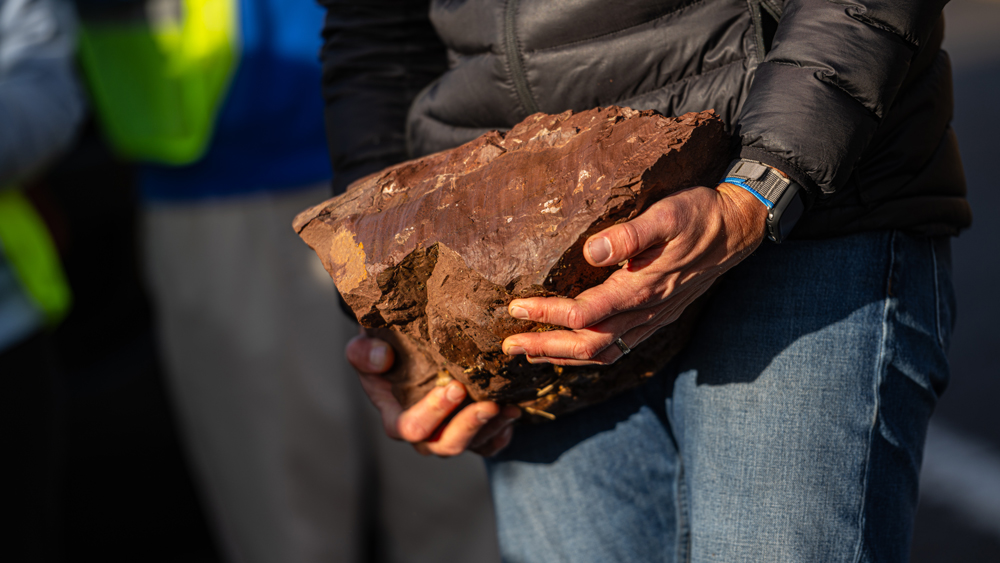Journey through time
Lafayette continues its tradition of geological expeditions to Ringing Rocks Park.

Photo by Adam Atkinson
Professor Dave Sunderlin’s GEOL 130 class, Dinosaur, Darwin, and Deep Time, is all about the journey—both across the Lehigh Valley and billions of years of geologic time. “The course is context for everything that people experience as they walk around the planet,” Sunderlin says.
According to Sunderlin, there are fewer places better to take in eras-long geologic history than Ringing Rocks Park in Upper Black Eddy, Pa. “I can’t imagine a geologist who’s based in Easton not going to Ringing Rocks,” Sunderlin says. “There are lots of little spots that have great examples for teaching, but are also really important for the history of geology on the continent.” In November, Sunderlin and his students made the trip to Ringing Rocks—about a 30-minute drive south of campus—to catch a glimpse of this history for themselves.
“We look at sedimentary rocks there that have a big fault through them, which suggests that there was a spreading or extension,” Sunderlin explains. “Faults happen when there are shifts in tectonic plates and, in this case, the shift had to do with the initial pulling apart of Africa from North America.” One of these faults eventually became the Atlantic Ocean during the breakup of Pangea. Trips to Ringing Rocks engage all senses—the name of the park comes from the most well-known feature of the boulder field, where visitors can strike the rocks and listen for a chime-like ring. Sunderlin believes these expeditions help students envision themselves and their environment, from the breakup of Pangea to the Ice Ages to present day.
The class then trekked to a rare place where budding geologists can see all three types of rock in one location: sedimentary layers at the base of a waterfall, “cooked” sedimentary rocks that have become metamorphic rocks, and the igneous rocks that are responsible for heating them. “You can see sedimentary, metamorphic, and igneous rocks in the same picture frame, which is really a rare thing to see in the world,” Sunderlin says.
Harvest Gil ’25, a geology major who’s visited Ringing Rocks several times, remembers the impact of Sunderlin’s introductory geology course. The class, which she took during her first semester on College Hill, changed the trajectory of her studies. “I wanted to pursue more of a natural history and evolutionary studies path,” says Gil, who was originally an environmental science major. “Since becoming a geology major, I have seen the world in such a raw and rich way. Being in such a geologically rich environment has been a blessing, and we couldn’t do the things we do without on-site experience.”
While serving as Sunderlin’s teaching assistant for two of her visits to Ringing Rocks, Gil has seen the expedition have the same impact on her students. “One of my favorite memories has been watching my students work to understand why deposited rocks are where they are and what their environment of deposition was,” she recalls. Becca Mitchell ’24, who worked as Sunderlin’s teaching assistant in the fall, also enjoyed observing students explore the seven-acre field of massive boulders. “People get excited about geology without realizing it,” she says. “Students go crazy hitting the rocks with rock hammers and climbing all over the rock field.”
The College’s relationship with the park stretches back over a century. Sunderlin has taken his students to the site every year since his arrival at the College in 2006. Lawrence Malinconico, associate professor of geology and geophysics, has done the same since joining the faculty in 1989, along with several years of guided “Family Weekend” tours of the location. According to Malinconico, faculty-led class trips can be traced back to as early as 1964, when former professor Richard Faas brought his students there (and even advised a student writing a thesis about why the rocks ring). And, in 1913, the student newspaper mentions trips to Ringing Rocks as a feature of early student life at Lafayette.
The hands-on learning experience that Ringing Rocks provides brings the discipline of geology alive for students. “Within geology, a lot of the ideas that we’re trying to get across are conveyed and taught better when you’re not in a place that’s inside, but instead when you’re outside amongst the rocks in the puzzle itself,” Sunderlin says. “This shared experience of being out in the field with other people with curiosity all over the place is really bonding, and I think it’s a really valuable experience for students.”
Did you visit Ringing Rocks? Tell us about it at lafayettemagazine@lafayette.edu.





